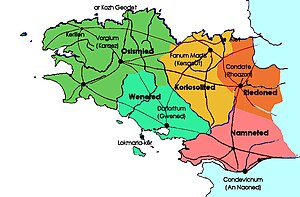Osismii

The Osismii, Ossismii, or Ostimii (also Ossismi, Osismi) were a
Etymology
They are mentioned as Osismos and Osismi (var. ossismi) by
Secondly, there are the Osismii (whom Pytheas calls the Ostimii), who live on a promontory that projects quite far out into the ocean, though not so far as he and those who have trusted him say.
— Strabo 1917, Geōgraphiká, 4:4:1.
The Gaulish ethnonym Ostim(i)i (sing. Ostim(i)os) literally means 'the ultimate', that is to say 'the remotest people', 'those who dwell at the extremity of the Armorican Peninsula'. It derives from the Celtic stem ostim- ('ultimate, extreme'), itself from an earlier *postim- ('last'; cf. Lat. postumus 'last-born, final'). In Middle French, the territory they occupied was known as (Fine) Posterne.[7]
Geography

The territory of the Osismii was located at the extremity of the
Pytheas situated the Osismii at the end of the peninsula of Kabaïon, which is not clearly identifiable today. This could be related to large peninsula of
Their chief town was Vorgium (present-day Carhaix).[8]
History
They submitted to
References
Primary sources
- ISBN 978-0674990562.
Bibliography
- ISBN 9782877723695.
- Falileyev, Alexander (2010). Dictionary of Continental Celtic Place-names: A Celtic Companion to the Barrington Atlas of the Greek and Roman World. CMCS. ISBN 978-0955718236.
- Lafond, Yves (2006). "Os(s)ismi(i)". Brill's New Pauly. .
Further reading
- Smith, Julia M. H. Province and Empire: Brittany and the Carolingians. Cambridge: Cambridge University Press, 1992.
See also
- Veneti (Gaul)
- List of Celtic tribes


